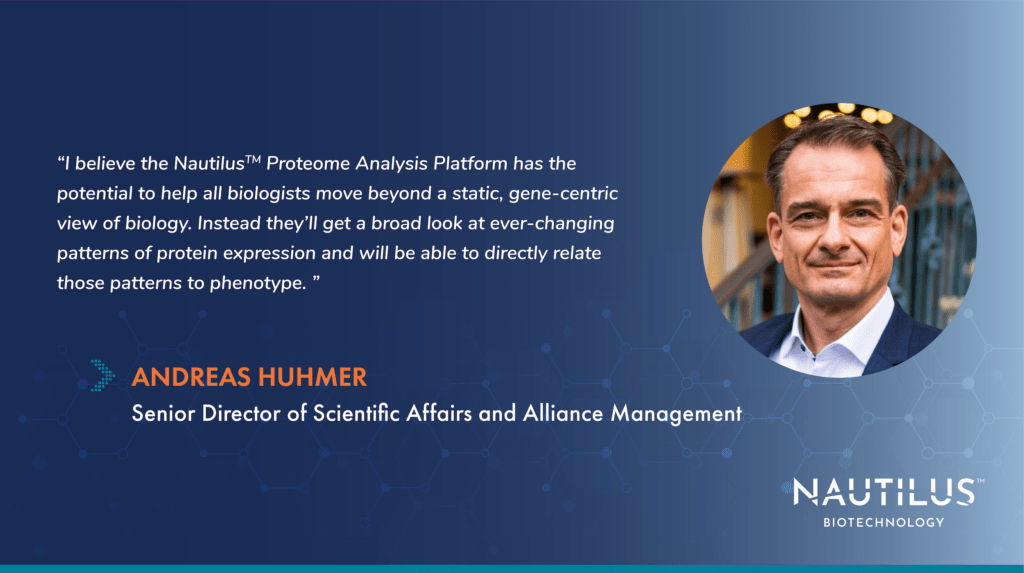
Interview with Andreas Huhmer – Senior Director of Scientific Affairs and Alliance Management

Tyler Ford
November 9, 2023

After several decades of high-profile experience developing mass spectrometry technologies with Thermo Fisher Scientific, Andreas Huhmer recently joined Nautilus as Senior Director of Scientific Affairs and Alliance Management. He has rapidly immersed himself in the technology underlying the NautilusTM Proteome Analysis Platform while beginning to catalyze essential collaborations that will drive our business forward. In this blog post, he describes why he’s excited to see researchers begin to use the Nautilus Platform.
Find Andreas on our Translating Proteomics podcast
Early fascination with the complexity and intricate dynamics of proteins
In my graduate work, I studied protein aging. I focused on a protein whose oxidation and cleavage leads to a cascade of events that drastically change cellular function. This sort of domino effect was astounding to me and, even then, made it clear that we need to be able to study the temporal dynamics of proteins at a broad scale to understand biology.
I began my professional career focused on technology development. I enjoy technology development because transformative technologies can lead to a cascade of insights and, much like my oxidized protein, result in another kind of domino effect that can change entire fields and ways of thinking. At the time, genomics technologies were transforming how we think about genes. Knowing the power of proteins, I wanted to work on a technology that could do the same for them. Mass spectrometry was emerging as that transformative technology and I’m proud as well as grateful that I got to work on such a successful technology for over two decades!
The transformative power and limitations of mass spectrometry
The reason mass spectrometry was so transformative is it gave us the first insights into the scale, heterogeneity, and dynamic nature of the proteome. Before mass spectrometry, we could only guess how many of the 20,000 gene-encoded proteins were produced and had little understanding of where they were produced in the body. Now, we have nearly completed the Human Proteome Project and can point to the locations where roughly 93% of gene-encoded proteins have been detected.
Unfortunately, the more you target mass spectrometry to detect rare proteins of interest, the more you miss out on unexpected changes to other parts of the proteome. You can shine a spotlight on particular proteins with mass spec, but you don’t see what’s outside that spotlight. Thus, even though mass spectrometry has made it clear that the proteome is highly heterogenous, it is not well suited to routinely capturing that heterogeneity.
The transformative nature of the NautilusTM Proteome Analysis Platform
In the design of the Nautilus Proteome Analysis Platform, Nautilus founder Parag Mallick set out to create a technology that overcomes the challenges of mass spectrometry, and it shows. First and foremost, the platform is accessible by design. Single-molecule protein counting across samples will greatly simplify data analysis while the high dynamic range enabled by our flow cells will simplify experimental workflows. With the platform, researchers across a wide range of disciplines should be able to get comprehensive views of the proteome using kits with ease of use comparable to genomics.
If the proteome is a vast playground that was previously open only to mass spec experts, the Nautilus platform should open it to many more people who will find new ways to explore. Critically, the platform’s ease of use means that it should be more practical for researchers to study the temporal dynamics of the proteome through time course experiments. This is huge because, as I learned in graduate school, dynamic changes in the proteome are driven by dynamic modifications to individual proteins that control biology.
Indeed, biomarker discovery is just one application that could be transformed by the ability to measure protein dynamics. While many researchers currently search for individual proteins as “smoking gun” biomarkers, it is gains or losses of heterogeneity and dynamic fluctuations in patterns of protein expression that will become the useful biomarkers of the future. These can only be discerned through a platform like ours.
More broadly speaking, I believe the Nautilus Proteome Analysis Platform has the potential to help all biologists move beyond a static, gene-centric view of biology. Instead, they’ll get a broad look at ever-changing patterns of protein expression and will be able to directly relate those patterns to phenotype. All the while, they’ll be able to zoom in on single protein molecules through targeted proteoform studies to get an in-depth view of the mechanisms underlying these patterns. With these combined levels of temporally-resolved, broad, and targeted studies, we will gain a thorough understanding of biological function across cell types and organisms that can be applied for untold benefits.
MORE ARTICLES
